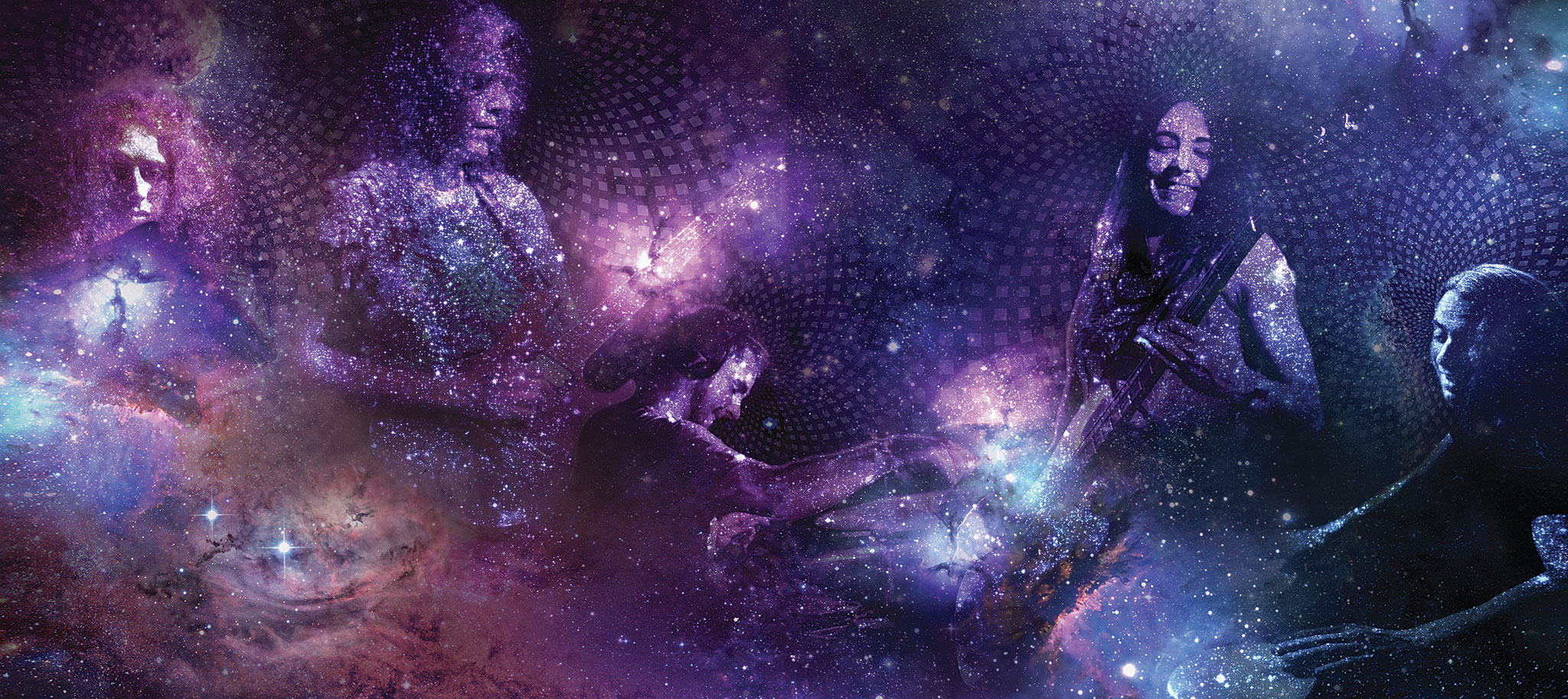
It’s a pleasant afternoon at the Norwich Waterfront and Ozric Tentacles’ founder, leader and only ever-present member, Ed Wynne, is in a relaxed mood outside, blissfully unaware that nearby, hundreds of Norwich City fans are celebrating a semi‑final win in the football.
The band are midway through a 24-date European tour to promote their new album, Technicians Of The Sacred. Their last, Paper Monkeys, was particularly well-received by the critics, yet Wynne has reservations.
“That was just another album. It was the first one recorded in America so it had a flavour of that, but for some reason I didn’t feel as comfortable with Paper Monkeys as the new one. All albums are just ‘another album’ in some ways. From our point of view, we just do our tunes. These are just slices in time. It’s like a conveyor belt with tunes coming out and occasionally you have to chop them like sausages.”
The American flavour of Paper Monkeys no doubt also comes from Wynne’s relocation to Colorado a few years ago. It’s a spectacularly beautiful state, and one he describes as serene.
“We don’t really see anybody. It’s kinda nice but a little lonely at times. It leaves a lot of space for making a lot of music. We’re at 8,000 feet, which is nice. You wake up and look down on snow-capped mountains and clouds. Pine trees everywhere, big boulders, canyons and cliff faces.”
There’s no doubt the landscape had an effect on the composing and recording of the Ozrics’ recent music, something Wynne freely admits. “Also the confusion of suddenly being in America,” he adds. “It’s very different to Somerset. Suddenly I was there in this windy, spacey place. Half of me was concentrating on the record and half of me was looking at the window, thinking, ‘Wow! Where do we live?’ But that album [Paper Monkeys] wasn’t quite as satisfying as this new one.
“This is our longest LP ever, hence the two discs,” he continues. “It also took longer. It took three years instead of one. During that time there were various chaotic things, like the house burning down.”
Sign up below to get the latest from Prog, plus exclusive special offers, direct to your inbox!
That unfortunate incident took place in June 2012, when their home in Colorado was partly destroyed by wildfires that had ravaged the area for over a week. Archive material was destroyed, as was their studio and some instruments. Ed’s wife, Ozrics bass player Brandi, reveals: “Losing the whole studio and all your reference points… trying to work digitally was a nightmarish experience. We’ll never do digital again.”

“The mixing we were doing digitally and it just wasn’t satisfying,” Ed agrees. “So then we tried taking each output and putting it into our analogue desk and suddenly it all came to life, which was something I hadn’t bargained for. Particularly the guitar sounds. Instead of sounding fizzy and mashed in there, they were suddenly rich and large and able to be heard in the mix. I’d always been told this but I’d never had to put it to the test. It was funny to flip between the digital and analogue version because in essence it’s the same, but one you can hear it properly and one you can’t.”
“You could actually hear the size of the desk in the headphones,” Brandi adds. “It seemed like you had this mess in your ears when you were listening to digital and then as we put it through with each channel on analogue, it just got bigger.”
That big sound goes with the big acclaim the album has received. Ed is justifiably proud when he tells us: “It’s at the top of the Amazon Classic Rock chart. People are loving it and responding really well. We’re playing Changa Masala, Epiphlioy and Zenlike Creature in the live set.”
The impactful and vibrant packaging suggests a sun/moon or night/day idea. We just have to ask: is there a prog-like concept here? “It became an idea when we realised we were going to have to have two discs,” Ed nods. “We said, ‘Let’s make them slightly different.’ Natan [Lenski, the sleeve artist], who was staying with us at the time, had the front cover and he was going through colour shifts. We saw the Night version and thought it looked great. It’s more like disc one is pop music and disc two is weird music.”
The album title and track names like Epiphlioy and Zenlike Creature suggest something religious, and Ed confirms that there are spiritual elements: “But not in any particular direction, just a general feeling of all and yet none. We had a session with a Mayan astrologer at Glastonbury five years ago who described us as ‘Galactic Activation Portals’. I haven’t quite determined what that entails! He said we were here to make this music and that the world needs it. He said that this could possibly be my last incarnation and this is a chance to leave the music behind. So we looked up our Mayan signs based on birthdate and he said, ‘You are technicians of the sacred!’”
We had a session with a Mayan astrologer who said this could possibly be my last incarnation and this is a chance to leave the music behind.
There are some interesting album credits to match its mind-bending inspiration. Shimmerscapes and Stratospheres, for example. Ed explains: “Shimmerscapes are landscapes made out of music. I can’t help but think of them as places rather than songs. I think of the tracks I make as windows onto worlds. Sliding Gliding Worlds, for example. I find them very easy to make. There are sounds on the synth that will create them if I play the right notes in sequence. They’re different every night and Silas is now learning them so he can take care of them for me.”
Silas is Ed’s 25-year-old son, who joined the band in 2009 on keyboards, and who knows all about the album’s Stratospheres: “They’re sounds that spiral around and make you feel like you’re in space.”
Ed adds, “I make the Shimmerscape landscape and he makes the sky on top of it. Live, anyway. Just saying ‘keyboards’ is boring and it’s so much more than that. It’s about creating spaces you can put your head inside. We use different terms on every album. Ether Strands. Dust Slabs – chunks of white noise that flicker through the sound. We have our language in the studio for certain things that we do. There are Bubbles too, which are quite common.”
It’s not a language the band have ever written down. “But it would be cool to do it,” Ed says. “We have names for the different scales we use too. We don’t know any musical theory. It’s all tadpoles on sticks.”
Away from the studio, the band are taking the album to live audiences across Europe. “We’re playing new tunes, which is always fun,” Ed reveals. “It makes a big difference to us. There’s also a certain symbiosis with everyone on the bus. The crew are now actually very pleasant. They’ve done it enough times now to know what it takes.
“There’s also my new guitar, an Ibanez EGEN 18, which is energising performances. When you’ve got a live band roaring, you’ve got to be able to cut through. The top pickup screams like a demon.”
With the new album out, and the tour underway, what’s next?
“The plan is to do a Nodens Ictus album, which is about half-finished already,” Ed explains. “That’s us lot but without bass and drums. We’re doing gigs and I’m playing guitar all the way through it. It’s really nice. No amp, just DI’d and clean. And then who knows? A new Ozrics album hopefully a year from now. Maybe it’ll be unplugged, an acoustic album. This album is almost a peak that we’ve reached. They’re all like that, but on this one we’ve really widened it out. Albums of a slightly different nature might be interesting.”
Influenced by the altitudinous location of their home in Colorado, the need to rebuild their studio after a fire, and the evolving dynamic of a family band, the new Ozrics album is a phoenix rising from the ashes, and a career high. If the Ozric Tentacles have eluded you so far, now’s a great time to tune in.
Technicians Of The Sacred is out now on Madfish. See http://www.ozrics.com for details.
